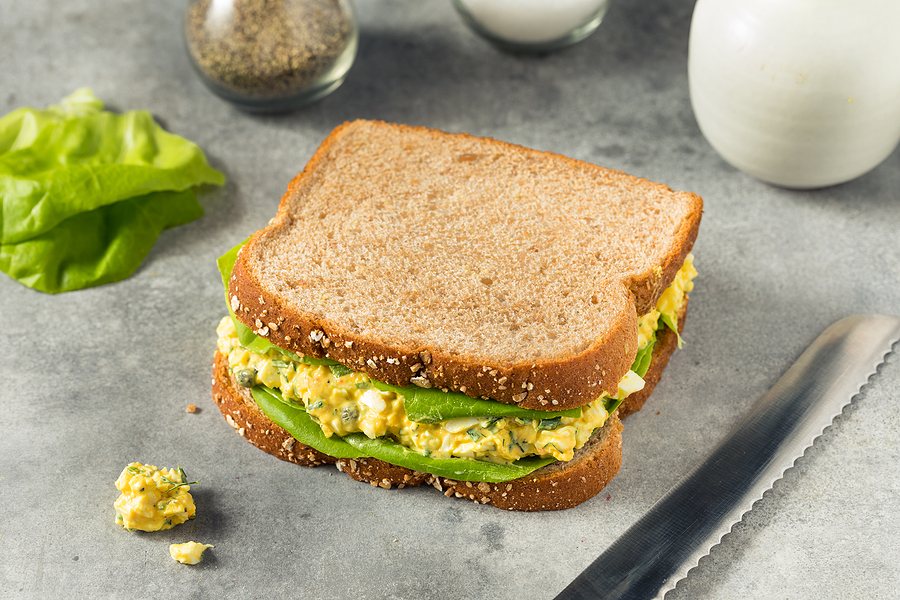
Can you build a healthy sandwich? The building blocks of a nutritious sandwich start by choosing the right bread and fillings. But, it’s easy to go overboard on less nutritious ingredients. From the bread through to the fixings, here are some tips for making a more nutritious sandwich.
The bread
Consider switching a more nutritious whole grain option. Why? Because whole grains contain more fibre, vitamins and minerals than refined grains. Diets higher in fibre may help reduce the risk of heart disease, type 2 diabetes and certain cancers. Choose bread that lists whole grain as the first ingredient. Also, check the Nutrition Facts Table and look for bread with at least two grams of fibre per slice.
Don’t be fooled by words like “cracked wheat,” or “multigrain.” If it doesn’t say whole grain, it probably isn’t. Dark-coloured or brown breads may also not be whole grain – they may just be coloured with molasses.
There are more options besides sliced bread! Go for bagels, pita, tortillas or naan. All come in whole grain versions. Read ingredient lists to know for sure. Look for the words “whole grain” as the first ingredient on the list.
The protein in your sandwich
Whether you stack your sandwich with meat, cheese, legumes, tofu or egg salad, it’s important to have a source of protein between the bread. Protein is necessary for building and repairing muscle and tissue. Plus, high protein foods help you feel full and satisfied. Try these options to add protein:
-
Beans, nuts and seeds make nutritious sandwich fillings. Use edamame or lentils to stuff a pita. Blend chickpeas with garlic to create your own chunky hummus with less fat and salt than the store-bought kind. For a change from peanut butter, try almond, hazelnut or cashew butter.
-
Try tofu or tempeh. You can cut extra firm tofu into 1 inch slices, marinade with your favourite sauce, like BBQ sauce, and then grill, bake, air fry or pan-fry for a tasty and nutritious sandwich filling.
-
Make extra roast beef or chicken at dinner and use leftovers in sandwiches. Home cooked meats usually have less sodium than processed sandwich meats like ham and salami. In fact, it is a good idea to limit processed meats as research has found that a diet high in processed meats increases the risk of colon cancer and other cancers like stomach and pancreatic cancer. Read more about nitrates and processed meats here.
-
When buying sliced cheese, look at the milk fat (MF) content. Buy reduced fat or lower fat cheeses with less than 20% MF. To limit sodium, choose fresh instead of processed cheese. For example, a slice of processed cheese can have 740 mg of sodium, while fresh cheddar can have just 210 mg.
-
Try canned fish like tuna or salmon. You can use a little mayonnaise and green onion to add flavour. Salmon is an especially good source of essential omega-3 fats.
-
Hard boiled eggs make a quick and nutritious addition to any sandwich. You can slice them or mash them and season with your favourite spices or spreads like mustard or mayonnaise.
Sandwich toppings
Build up the nutritional value of your sandwich with lots of veggies. Vegetables provide vitamins, minerals, fibre, and are low in calories. Beyond lettuce and tomato, these toppings provide a unique twist:
-
Red pepper and cucumber rings
-
Shredded carrots or beets
-
Kale, arugula or baby spinach
-
Grilled zucchini or eggplant
-
Fresh basil, parsley or coriander
Fruit is great on sandwiches too! How about a Soy butter and banana roll, tuna with sliced peaches, or cheddar with apple?
Sandwich spreads
Skip butter and choose some of these nutritious spreads:
-
Avocado contains heart-healthy monounsaturated fats and adds rich flavour to sandwiches.
-
Hummus is a source of fibre and protein and adds a creamy, nutty flavour.
-
Mayonnaise, oil-based vinaigrettes and non-hydrogenated margarine also contain healthy fats. You only need a couple teaspoons to add flavour.
-
Salsa is a flavourful and nutritious choice. It is low in saturated fat and is made from vegetables. Choose lower sodium brands or make your own.
-
Add some zip to your sandwich with mustard. It is low in sugar and fat. Mustard can be high in sodium so watch your portion size.
-
Try wasabi (Japanese mustard) or horseradish if you like it hot – they also have less sodium than many other spreads.
Sodium content in common condiments
|
Condiment
|
Sodium per 1 tablespoon (15 mL)
|
|
Yellow mustard
|
179 mg
|
|
Dijon mustard
|
204 mg
|
|
Wasabi
|
1 mg
|
|
Horseradish
|
48 mg
|
|
Ketchup
|
169 mg
|
|
Salsa
|
100 mg
|
|
Hummus
|
54 mg
|
Sandwich recipes to try:
Chicken Salad Sandwich - Two Ways
Chicken Tzatziki Roll Ups
Mango Chicken Wraps
How can a dietitian help?
Dietitians can support you throughout many phases of your life, from pregnancy to eating well when you are older. Counselling sessions with a dietitian can also help you prevent and treat health conditions like diabetes and heart disease. Your dietitian will work with you to give you personalized advice that meets your lifestyle and goals. Connect with a dietitian today!
Bottom line
You are the builder of your healthy sandwich. Begin with a nutritious base of whole grain bread or other whole grain options. Add a source of protein, loads of crunchy vegetables or fruit, and a tasty sauce that’s filled with zip but not sodium.
You may also be interested in:
How to Choose the Best Sliced Bread
Choosing Whole Grains FAQs
Top 5 Reasons to See a Dietitian
This article was written and reviewed by dietitians from Dietitians of Canada. The advice in this article is intended as general information and should not replace advice given by your dietitian or healthcare provider.
Last Update – February 19, 2023